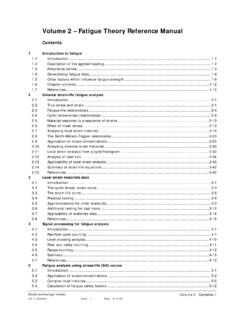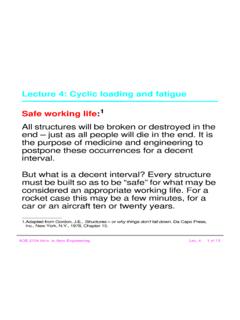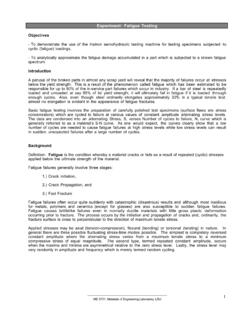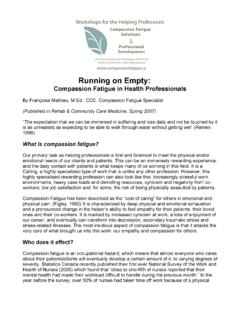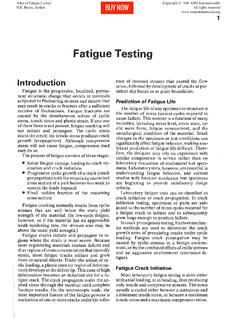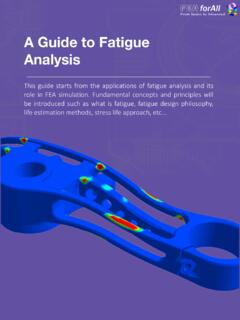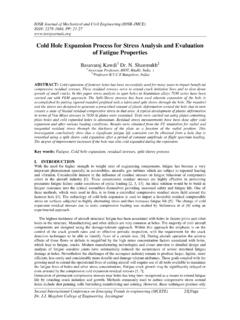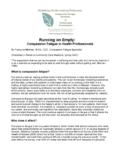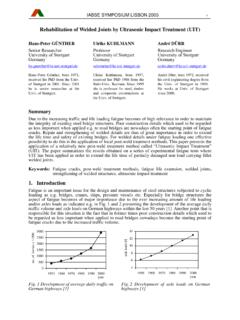Transcription of RR207- Review of low cycle fatigue resistance
1 HSEH ealth & SafetyExecutiveReview of low cycle fatigue resistance Prepared by Failure Control Limited for the Health and Safety Executive 2004 RESEARCH REPORT 207 HSEH ealth & SafetyExecutiveReview of low cycle fatigue resistance Failure Control Limited Unit 30 Smithbrook Kilns Cranleigh Surrey GU6 8JJ The S-N method of fatigue life assessment is stress based, and is only fully applicable to cyclic stresses in the elastic range. However, in offshore installations the presence of stress concentrations at nodes and other connections can, in some circumstances, lead to cyclic stresses that exceed the yield stress of the material locally. This study is aimed at reviewing the current status of design advice and more recent experimental data with the objective of evaluating the treatment of high stress ranges. This report and the work it describes were funded by the Health and Safety Executive (HSE).
2 Its contents, including any opinions and/or conclusions expressed, are those of the authors alone and do not necessarily reflect HSE policy. HSE BOOKS Crown copyright 2004 First published 2004 ISBN 0 7176 2830 2 All rights reserved. No part of this publication may be reproduced, stored in a retrieval system, or transmitted in any form or by any means (electronic, mechanical, photocopying, recording or otherwise) without the prior written permission of the copyright owner. Applications for reproduction should be made in writing to: Licensing Division, Her Majesty's Stationery Office, St Clements House, 2-16 Colegate, Norwich NR3 1BQ or by e-mail to ii SUMMARY The S-N method of fatigue life assessment is stress based, and is only fully applicable to cyclic stresses in the elastic range. However, in offshore installations the presence of stress concentrations at nodes and other connections can, in some circumstances, lead to cyclic stresses that exceed the yield stress of the material locally.
3 This study is aimed at reviewing the current status of design advice and more recent experimental data with the objective of evaluating the treatment of high stress ranges. Previous reviews of the low cycle fatigue resistance of plate details and tubular connections were supplemented by more recent data identified by a literature search. The present study indicates that a fatigue life less than that predicted by accepted design curves is possible in the high-stress low-life region, but only under laboratory conditions. The very high levels of cyclic stress required to promote this behaviour would not prove acceptable in static strength checks and would not occur in actual offshore installations. The HSE Guidance Notes placed restrictions on the applicability of S/N curves in the high stress low cycle region because of a lack of experimental data, but did not identify what fatigue damage might be expected when these limits were exceeded.
4 Reanalysis of screened data now suggests that there is no need to impose such a restriction in the future, iii iv CONTENTS INTRODUCTION 1 Background 1 HSE fatigue Guidance 1 DNV RP-C203 (2000) and API RP-2A 2 Other limit states members and plates 2 Other limit states tubular joints 2 Strain based methods 3 fatigue DATA FOR PLATES 4 Review of data 4 Transverse butt welds 4 Longitudinal fillet welds 5 Transverse non-load carrying fillet welds 6 Transverse load carrying fillet welds 6 fatigue DATA FOR TUBULAR JOINTS 8 Delft compilation Static modes of failure Review of data T-joint data X-joint data DISCUSSION CONCLUSIONS REFERENCES FIGURES 8 8 9 9 9 10 12 13 15 v vi 1. INTRODUCTION BACKGROUND The casual paper-clip bender is well aware that that, after a short time, their diversion is terminated by an early failure of the clip.
5 Assessing the likely fatigue life of paper-clips under this extreme loading regime is more demanding than many engineering applications because the clip experiences a combination of elastic and plastic strains. Since the familiar S-N method of fatigue life assessment is stress based, it is only fully applicable to cyclic stresses below the yield point of the material. In offshore installations the presence of stress concentrations at nodes and other connections can, in some circumstances, lead to cyclic stresses that exceed the yield stress of the material locally. While the strains associated with this post-yield behaviour will be limited by the elastic global response of the structure there is still some uncertainty as to how this behaviour should be accounted for in assessing the fatigue limit state. Most design codes or design guidance either do not consider this question, or set limits on the applicability of the guidance so that the issue is avoided for those regions where experimental evidence is lacking or unreliable.
6 This study is aimed at reviewing the current status of design advice and more recent experimental data with the objective of updating the treatment of high stress ranges where possible. HSE fatigue GUIDANCEA lthough no longer actively supported by the HSE, the fatigue sections of Offshore Installations: Guidance on design construction and certification were revised extensively in 1995 incorporating the findings of a Review panel(1). Advice is given on high stress cycles in fatigue at Section (d). For welded plates and tubular joints in air or seawater (with or without CP) values of the stress range considered in (b) above greater than twice the yield stress need special consideration. Further information is given in the Background Document. The limits from static strength should be considered (Section ).
7 The design tensile stress will be governed by a fracture criterion (Section ) or by the tensile limitations on normal member stress (Section ). For compressive loading , buckling considerations may be critical and should be included in the analysis. The Review panel referred to above noted that in previous guidance (pre-1995) the T curve for tubular joints was limited to a maximum hot spot stress range equal to twice the material yield stress, 2Sy. This was due to a lack of data in the high stress region and a concern that the fatigue process might change from a stress controlled high cycle fatigue mechanism to strain controlled low cycle fatigue . It was noted that some tubular joints could experience stresses beyond this limit during severe conditions, although this mostly occurred in older platforms constructed from low yield stress steel, or when the joint geometric SCF exceeded 5, or both(2).
8 Previous Guidance gave a similar restriction for non-nodal connections (classes B-G) where the peak stress was primarily due to bending or a stress concentration. For simple axial stress the maximum stress range was restricted to twice the allowable axial stress of Sy for extreme loads and Sy for operating loads. 1 The Review committee concluded that the existing ( pre-1995) combination of limits on stress range and allowable stress for static loading were satisfactory, and that no extrapolation of the design curves to higher stress ranges was justified in the later guidance on the basis of the available data. DNV RP-C203 (2000) AND API RP-2A (1991)Neither the DNV recommended practice C203(3), nor API-RP2A(4) require separate consideration of high stress ranges. In both documents the S-N design curves continue in the high stress low cycle regime without modification.
9 The commentary to DNV RP-C203 presents a plot of the contribution to fatigue damage for different regions of a Weibull distribution when the fatigue design line has slopes of m=3 and m=5 (N>107 cycles) and a total fatigue damage (Miners Number) of and This showed that the loads comprising the highest 1000 cycles (severe storm loading) made a negligibly small contribution to the overall fatigue damage. OTHER LIMIT STATES MEMBERS AND PLATESIn the assessment of offshore structures, the ultimate/serviceability limit states and the fatigue limit state are normally considered as separate aspects of design. However, practical considerations such as the need to design a member or joint configuration to acceptable limits for extreme loading is likely to influence the magnitude of the cyclic stress in severe sea states.
10 Large scale plasticity is prevented in offshore structures by limitations on either the allowable stress under extreme loading or suitable application of load and resistance factor design. For example, Section of the Guidance Notes referred to above. This states: In no case should the calculated tensile stress in a member exceed 60% of the yield stress under normal operating conditions and 80% of the yield stress under extreme loading conditions. All members and panels should remain nominally elastic and, even under those storm conditions relevant to fatigue assessment, the nominal tensile stress should be limited to Therefore, cyclic plasticity in plate type construction and tubular members will tend to be restricted to localised regions and discontinuities such as member intersection, holes and other sources of stress concentration.










